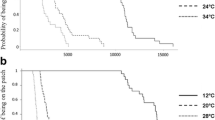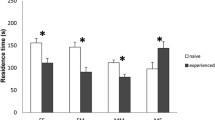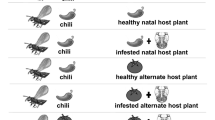Abstract
The effect of experiences, such as contact with honeydew, rejections of hosts, and ovipositions in hosts, and of temperature on the time allocation of individualEncarsia formosa female parasitoids on tomato leaflets have been studied. Behavioral records were analyzed by means of the proportional hazards model. Analyses were carried out at two levels: (1) the tendency of leaving and (2) the tendency of changing from one leaf side to another. The patch-leaving behavior ofE. formosa can be described by a stochastic threshold mechanism, which is characterized by a certain tendency (probability per time) to leave. The median time from being placed on the leaflet or, if it occurred, from the latest encounter with a host until leaving was 18.6 min. The median time for changing from one leaf side to the other was initially 11.6 min and dropped to 5.7 min after both leaf sides had been visited. The effect of temperature, ranging from 20 to 30°C, was negligible. The presence of honeydew as well as the first oviposition in an unparasitized host decreased the tendency to leave, thus increasing the giving up time (GUT) since the latest encounter with a host. Encounters with parasitized hosts did not affect the GUT since latest encounter; as a result, the total residence time increased. After the first oviposition in an unparasitized host the tendency of changing from the lower leaf side on which hosts were present to the upper side was decreased. The presence of honeydew did not affect the tendency of changing leaf sides.
Similar content being viewed by others
References
Bressers, M., Meelis, E., Haccou, P., and Kruk, M. (1991). When did it really start or stop: The impact of censored observations on the analysis of duration.Behav. Process. 23: 1–20.
Charnov, E. R. (1976). Optimal foraging: The marginal value theorem.Theor. Pop. Biol. 9: 129–136.
Cox, D. R. (1972). Regression models and life tables.Biometrics 38: 67–77.
Doutt, R. L. (1964). Biological characteristics of entomophagous adults. In: deBach, P. (ed.),Biological Control of Insects Pests and Weeds, Chapman and Hall, London, pp. 145–167.
Driessen, G., and Hemerik, L. (1992). The time and egg budget ofLeptopilina clavipes, a parasitoid of larvalDrosophila.Ecol. Entomol. 17: 17–27.
Gibb, J. A. (1962). Tinbergen's hypothesis of the role of specific search images. Ibis104: 106–111.
Green, R. F. (1987). Stochastic models of optimal foraging. In Kamil, A. C., Krebs, J. R., and Pulliam, H. R. (eds.),Foraging Behaviour, Plenum, New York, pp. 273–302.
Haccou, P., and Hemerik, L. (1985). The influence of larval dispersal in the cinnabar moth (Tyria jacobaeae) on predation by the red wood ant (Formica polyctena): An analysis based on the proportional hazards model.J. Anim. Ecol. 54: 755–770.
Haccou, P., de Vlas, S. J., van Alphen, J. J. M., and Visser, M. E. (1991). Information processing by foragers: Effects of intra-patch experience on the leaving tendency ofLeptopilina heterotoma.J. Anim. Ecol. 60: 93–106.
Hågvar, E. B., and Hofsvang, T. (1991). Aphid parasitoids (Hymenoptera, Aphidiidae): Biology, host selection and use in biological control.Biocontrol News Inform. 12(1): 13–41.
Hemerik, L., Driessen, G., and Haccou, P. (1993). Effects of intra-patch experiences on patch time, search time and searching efficiency of the parasitoidLeptopilina clavipes (Hartig).J. Anim. Ecol. 62: 33–44.
Hussey, N. W., Parr, W. J., and Stacey, D. L. (1976). Studies on the dispersal of the whitefly parasiteEncarsia formosa.IOBC/WPRS Bull. 4: 115–120.
Iwasa, Y., Higashi, M., and Yamamura, N. (1981). Prey distribution as a factor determining the choise of optimal foraging strategy.Am. Nat. 117: 710–723.
Kalbfleisch, J. D., and Prentice, R. L. (1980).The Statistical Analysis of Failure Time Data, Wiley and Sons, New York.
Krebs, J. R. (1973). Behavioural aspects of predation. In Bateson, P. P. G., and Klopfer, P. H. (eds.).Perspectives in Ethology, Plenum Press, New York, pp. 73–111.
Ledieu, M. S. (1976). Dispersal of the parasiteEncarsia formosa as influenced by its host,Trialeurodes vaporariorum.IOBC/WPRS Bull. 4: 121–124.
Lei Hong and Xu Rumei (1994). Studies on honeydew excretion by greenhouse whitefly,Trialeurodes vaporariorum (Westw.) on its host plant,Cucumis sativus. J. Appl. Entomol. (in press).
Madueke, E. (1979).Biological Control of Trialeurodes vaporariorum, Ph.D. thesis, University of Cambridge, Cambridge.
McNair, J. N. (1982). Optimal giving-up times and the marginal value theorem.Am. Nat. 119: 511–529.
McNamara, J., and Houston, A. I. (1987). Foraging in patches: There is more than life than the marginal value theorem. In Commons, M. L., Kacelnik, A., and Shettleworth, S. J. (eds.),Quantitative Analysis of Behaviour VI, Lawrence Erlbaum Associates, London, pp. 23–39.
Murdoch, W. W., and Oaten, A. (1975). Predation and population stability.Adv. Ecol. Res. 6: 2–132.
Nell, H. W., Sevenster-van der Lelie, L. A., Woets, J., and van Lenteren, J. C. (1976). The parasite-host relationship betweenEncarsia formosa (Hymenoptera: Aphelinidae) andTrialeurodes vaporariorum (Homoptera: Aleyrodidae). II. Selection of host stages for oviposition and feeding by the parasite.J. Appl. Entomol. 81: 372–376.
Noldus, L. P. J. J. (1991). The Observer: A software system for collection and analysis of observational data.Behav. Res. Meth. Instr. Comp. 23: 415–429.
Noldus, L. P. J. J., and van Lenteren, J. C. (1990). Host aggregation and parasitoid behaviour: Biological control in a close system. In Mackauer, M., Ehler, L. E., and Roland, J. (eds.),Critical Issues in Biological Control, Intercept, Andover, MA, pp. 229–262.
Nordlund, D. A., Jones, R. L., and Lewis, W. J. (1981).Semiochemicals. Their Role in Pest Control, John Wiley and Sons, New York.
Salt, G. (1935). Experimental studies in insect parasitism. III. Host selection.Proc. R. Soc. London Ser. B Biol. Sci. 117: 413–435.
Sugimoto, T., and Tsujimoto, S. (1988). Stopping rule of host search by the parasitoid,Chrysocharis pentheus (Hymenoptera: Eulophidae), in host patches.Res. Popul. Ecol. 30: 123–133.
van Lenteren, J. C. (1991). Encounters with parasitized hosts: To leave or not to leave a patch.Neth. J. Zool. 41: 144–157.
van Lenteren, J. C., Nell, H. W., Sevenster-van der Lelie, L. A., and Woets, J. (1976). The parasite-host relationship betweenEncarsia formosa (Hymenoptera: Aphelinidae) andTrialeurodes vaporariorum (Homoptera: Aleyrodidae). I. Host finding by the parasite.Entomol. Exp. Appl. 20: 123–130.
van Lenteren, J. C., Nell, H. W., and Sevenster-van der Lelie, L. A. (1980). The parasite-host relationship betweenEncarsia formosa (Hymenoptera: Aphelinidae) andTrialeurodes vaporariorum (Homoptera: Aleyrodidae). IV. Oviposition behaviour of the parasite, with aspects of host selection, host discrimination and host feeding.J. Appl. Entomol. 89: 442–454.
van Roermund, H. J. W., and van Lenteren, J. C. (1992). The parasite-host relationship betweenEncarsia formosa (Hymenoptera: Aphelinidae) andTrialeurodes vaporariorum (Homoptera: Aleyrodidae). XXXIV. Life-history parameters of the greenhouse whitefly,Trialeurodes vaporariorum as a function of host plant and temperature.Wageningen Agric. Univ. Papers 92.3: 1–102.
van Roermund, H. J. W., and van Lenteren, J. C. (1994a). Analysis of the foraging behavior of the whitefly parasitoidEncarsia formosa on a leaf. (in prep.).
van Roermund, H. J. W., and van Lenteren, J. C. (1994b). Foraging behavior of the whitefly parasitoidEncarsia formosa on tomato leaflets. (in prep.).
van Vianen, A., and van Lenteren, J. C. (1986). The parasite-host relationship betweenEncarsia formosa (Hymenoptera: Aphelinidae) andTrialeurodes vaporariorum (Homoptera: Aleyrodidae). XV. Oogenesis and oviposition ofEncarsia formosa.J. Appl. Entomol. 102: 130–139.
van Vianen, A., and van der Veire, M. (1988). Honeydew of the greenhouse whitefly,Trialeurodes vaporariorum (Westwood), as a contact kairomone for its parasiteEncarsia formosa Gahan.Med. Fac. Landbouww. Rijksuniv. Gent 53(3a): 949–954.
Vet, L. E. M., and Dicke, M. (1992). Ecology of infochemical use by natural enemies in a tritrophic context.Annu. Rev. Entomol. 37: 141–172.
Waage, J. K. (1979). Foraging for patchily distributed hosts by the parasitoidNemeritis canescens.J. Anim. Ecol. 48: 353–371.
Author information
Authors and Affiliations
Rights and permissions
About this article
Cite this article
van Roermund, H.J.W., Hemerik, L. & van Lenteren, J.C. Influence of intrapatch experiences and temperature on the time allocation of the whitefly parasitoidEncarsia formosa (Hymenoptera: Aphelinidae). J Insect Behav 7, 483–501 (1994). https://doi.org/10.1007/BF02025445
Accepted:
Issue Date:
DOI: https://doi.org/10.1007/BF02025445




